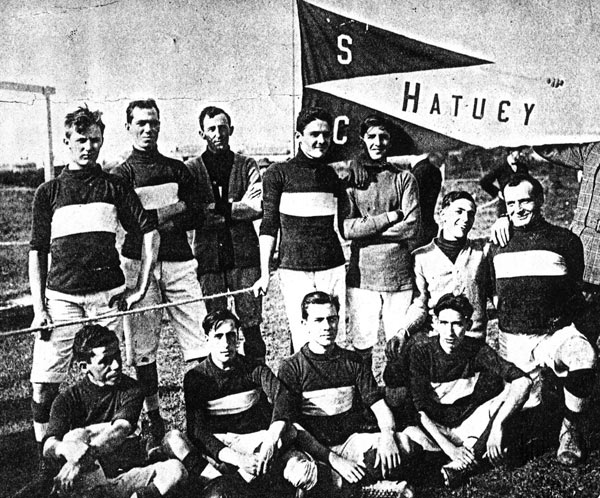SC Hatüey
Soccer is a relatively minor sport in modern Cuba. The socialist republic, which has resisted in so many ways the malign influence of it's near neighbour the USA, has embraced American sports.The first football club in Cuba was SC Hatüey, founded in 1907. The Havana based club took their name from an indigenous chief who had resisted Spanish colonization. The name of the club is usually given with the Spanish prefix CD (Club Deportes) but as the contemporary banner shows, they used the Anglicized SC (sports club).
In 1909 Britons resident in Havana created the Rovers Athletic Club. The two clubs did not meet for a further 2 years. In the meantime however in February 1910 Hatüey played a match against a team of British sailors and won 8-0.
In December 1911 SC Hatüey and Rovers AC met for the first official match in the history of Cuban football. Hatüey were a Cuban club, whereas Rovers was composed of British expatriates. It was the first encounter in a 4 team league. Rovers won 1-0 thanks to a goal from founder Jack C. Orr. Some of the results are lost to posterity. Rovers AC, however, were the national champions in that inaugural season (1912). the other teams in the league were CD Hispano-América and Euskeria SC.
The Cuban Football Association was founded in 1924 and Cuba joined FIFA in 1929.
National champions:
1912 Rovers AC
1913 SC Hatüey
1914 Rovers AC
1915 Hispano América
1916 La Habana FC
1917 Iberia
1918 Iberia
1919 Hispano América
1920 Hispano América
1921 Hispano América
1922 Iberia
1923 Iberia
1924 Olimpia
1925 Fortuna
1926 Real Iberia
1927 Juventud Asturiana
1928 Real Iberia
1929 Real Iberia
1930 Deportivo Español
1931 DC Gallego
1932 DC Gallego
1933 Juventud Asturiana
1934 Real Iberia
1935 Juventud Asturiana
1936 Juventud Asturiana
1937 DC Gallego
Internationals:
In 1930 a Cuba representative XI played Real Sociedad, losing 7-1.
Cuba entered international football whern Havana hosted the 1930 Central American and Caribbean Games.
16.03.30 Cuba 3-1 Jamaica
20.03.30 Cuba 7-0 Honduras
23.03.30 Cuba 5-0 Honduras
30.03.30 Cuba 2-1 Costa Rica
01.04.30 Cuba 5-2 El Salvador
This sequence of results secured the gold medal for Cuba.
Cuba entered the 1934 World Cup. They played a series of matches with Haiti for the right to face Mexico. The winners of the Mexico v Cuba series would play the USA for a place in the finals.
This sequence of results secured the gold medal for Cuba.
Cuba entered the 1934 World Cup. They played a series of matches with Haiti for the right to face Mexico. The winners of the Mexico v Cuba series would play the USA for a place in the finals.
28.01.34 Haiti 1-3 Cuba
01.02.34 Haiti 1-1 Cuba
04.02.34 Haiti 0-6 Cuba
04.03.34 Mexico 3-2 Cuba
11.03.34 Mexico 5-0 Cuba
18.03.34 Mexico 4-1 Cuba
Cuba's next batch of international fixtures came at the 1935 Central American and Caribbean Games in San Salvador, El Salvador. On this occasion Cuba could only manage bronze, sharing 3rd place with El Salvador.
Cuba's next batch of international fixtures came at the 1935 Central American and Caribbean Games in San Salvador, El Salvador. On this occasion Cuba could only manage bronze, sharing 3rd place with El Salvador.
24.03.35 El Salvador 4-1 Cuba (El Salvador)
25.03.35 Cuba 3-0 Honduras (El Salvador)
27.03.35 Cuba 2-1 Guatemala (El Salvador)
30.03.35 Cuba 1-6 Mexico (El Salvador)
31.03.35 Cuba 1-2 Costa Rica (El Salvador)



.jpg)







.jpg)






